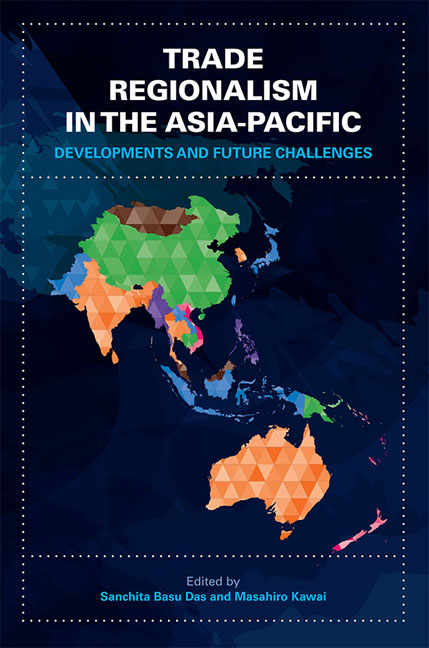Book contents
- Frontmatter
- Contents
- Foreword
- Acknowledgments
- List of Abbreviations
- The Contributors
- 1 Introductory Overview — Trade Regionalism in the Asia-Pacific: Developments and Future Challenges
- I The Trans-Pacific Partnership (TPP) Agreement
- 2 The Origins and Evolution of TPP Trade Negotiations
- 3 The Political Economy of Joining TPP: The Case of Malaysia
- 4 China and the TPP: Reflections and Responses
- 5 Japan and Entanglement of Regional Integration in the Asia-Pacific: Combining Cutting-Edge and Traditional Agendas
- II The Regional Comprehensive Economic Partnership (RCEP) Agreement
- III Regional Economic Integration: A Multi-stage Approach
- IV Old and Emerging Approaches to Asia-Pacific Regional Integration
- V Asia-Pacific Regional Integration: Towards Convergence?
- Index
2 - The Origins and Evolution of TPP Trade Negotiations
from I - The Trans-Pacific Partnership (TPP) Agreement
Published online by Cambridge University Press: 05 July 2016
- Frontmatter
- Contents
- Foreword
- Acknowledgments
- List of Abbreviations
- The Contributors
- 1 Introductory Overview — Trade Regionalism in the Asia-Pacific: Developments and Future Challenges
- I The Trans-Pacific Partnership (TPP) Agreement
- 2 The Origins and Evolution of TPP Trade Negotiations
- 3 The Political Economy of Joining TPP: The Case of Malaysia
- 4 China and the TPP: Reflections and Responses
- 5 Japan and Entanglement of Regional Integration in the Asia-Pacific: Combining Cutting-Edge and Traditional Agendas
- II The Regional Comprehensive Economic Partnership (RCEP) Agreement
- III Regional Economic Integration: A Multi-stage Approach
- IV Old and Emerging Approaches to Asia-Pacific Regional Integration
- V Asia-Pacific Regional Integration: Towards Convergence?
- Index
Summary
IN THE BEGINNING…
The Trans-Pacific Partnership (TPP) trade negotiations began life as a different trade agreement. Now known as the P4 or “Pacific Four”, the official name of the agreement, announced at the APEC (Asia-Pacific Economic Cooperation) Trade Ministers meeting in June 2005, was the Trans-Pacific Strategic Economic Partnership Agreement (TPSEP) (Lim, Elms, and Low 2012). The P4 linked together Brunei Darussalam, Chile, New Zealand, and Singapore. It grew out of attempts within APEC to create a larger economic free trade area. When these talks foundered, the leaders of the P4 countries pressed ahead with plans to demonstrate how small, largely open economies could still benefit from trade liberalization. However, given the quite modest levels of trade between the four, the P4 came into force in 2006 with very little attention (Elms and Lim 2012).
The original P4 negotiations closed without resolution on two difficult areas of negotiation — financial services and investment. The four country leaders elected to finish the agreement and then relaunch discussions on these outstanding issues within two years.
When the negotiations started in February 2008 over the two missing chapters, the United States also began to participate in the discussions (Business Day 2008). In September 2008, U.S. participation deepened with the announcement that the United States would seek to join the agreement in its entirety. When this happened, the P4 moved from a small experiment into something larger and much more interesting. Australia, Peru, and Vietnam also joined the talks. In 2008, the P4 agreement had morphed into the TPP with eight members.
The United States’ involvement with the P4 was an important decision given its relatively low number of trade deals. The United States opted to join the agreement in the twilight days of the George W. Bush administration. The U.S. announcement was made in September 2008, with the elections looming in November.
To make such a pronouncement ahead of a tight election might seem especially odd. At a minimum, it could have been argued that the decision could be easily postponed until after the election so the new administration could decide whether or not they wished to be involved in the trade arrangement. Instead, United States Trade Representative (USTR) Susan Schwab chose to ensure U.S. participation regardless of which party won control of the government.
- Type
- Chapter
- Information
- Trade Regionalism in the Asia-PacificDevelopments and Future Challenges, pp. 29 - 49Publisher: ISEAS–Yusof Ishak InstitutePrint publication year: 2016



